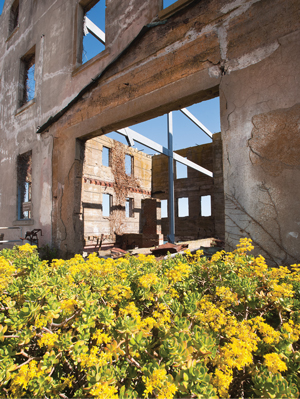When Dick Miner talks of earthworms, he nearly tears up. “These here are red wigglers,” he says softly, looking down at a cluster of squirming spaghetti strips the color of steak sauce he’s holding in his soil-covered hands. He even names worms he’s especially fond of, according to those who volunteer with the 69-year-old Miner on Alcatraz Island. Miner also raises the wigglers in the kitchen of his San Anselmo home. So, what’s with this love of all things annelid?
“Worms work wonders with compost,” Miner says, standing next to one of four closet-size compost bins on the northeast side of the 22-acre island. “They eat organic waste and turn it into some of the best fertilizer on earth.”
Miner has been working since 2003 to turn Alcatraz into home of one of the most beautiful garden collections in the Bay Area. All the gardens are infused with his compost. “During the years I’ve been here, I’ve done landscaping, carpentry, masonry, even built a concrete birdbath,” Miner says. “But now my primary job is, well, managing compost.”
Miner’s mix consists of hops from San Francisco’s Anchor Steam Brewery, grass clippings from his San Anselmo neighbors, manure he transports to the island in plastic bags from Petaluma chicken and horse ranches, and clippings from the island’s many plantings.
“The prison structures have their own feel—not to be compared with the gardens,” he says. “It’s not at all hard to become passionate about these gardens.”
The concept of passion has rarely been favorably associated with Alcatraz, once home to the federal penitentiary known as the Rock, an appropriate name because geologically the island is little more than a thin layer of soil covering a hump of sandstone that rises 140 feet above San Francisco Bay. The U.S. Army built there first, erecting a fortress in the mid-1800s. Following the Civil War, the fort became a military prison, and the guards dug holes in the sandstone and filled them with topsoil imported from the mainland. Within years, those cavities sprouted the native cactus, as well as Monterey cypress and even calla lilies that Miner and a team of more than 60 volunteers have brought back to life. After the 1906 San Francisco earthquake and in subsequent years, some civilian prisoners were sent to the island as well.
In 1934, Alcatraz was made a federal penitentiary, where only “the worst of the worst” were sent after proving themselves incorrigible in other U.S. prisons. In ensuing years, the wives of the wardens — along with trusted convicts — began creating gracious gardens of roses, geraniums, agaves and Jupiter’s beard. The government closed the prison in 1963, and nine years later Alcatraz became part of the Golden Gate National Recreation Area, which opened the prison to public tours. The gardens were all but neglected for 40 years.
Today, thanks to the Garden Conservancy, a nonprofit dedicated to the preservation of exceptional American gardens, along with the National Park Service, the Golden Gate National Parks Conservancy and dozens of volunteers, Alcatraz’s gardens are once again blooming profusely.
“In 2003, the garden restoration was conceived,” recalls Miner, a retired microbiologist, “and for almost the next three years all we did was clear out weeds and overgrown plant material.” Once the replanting began, decisions were made only after consultation with the three partnering organizations and careful perusal of historical photographs, some dating to the late 1800s, most from the 1920s through 1940s.
“We wanted to ‘restore’ the gardens as they once were,” says Garden Conservancy project manager Shelagh Fritz, “not add newer-type plants and modern colors.” These efforts resulted in seven garden areas on Alcatraz:
Main Road (and its accompanying wall) leading up to the cell house; abounds with ferns, ivies and succulents.
Rose Garden, originally planted in 1934, directly below Alcatraz’s massive water tank; now the site of a cedar greenhouse.
Officers’ Row, a large plot of fuchsias, lilies and geraniums where three Victorian homes once stood.
Warden’s House, a shade garden near the ruins of the home opposite the main cell house entrance.
Cell House Slope, dominated by the iconic lavender ice plant often called Persian carpet.
West Lawn, planted by prisoners in the 1940s when Pacific Heights residents sent over seed and plant material to make the island “more attractive.”
West Side Prisoner Gardens, the only plantings prisoners could see as they walked a heavily guarded path to work in the prison’s small factory.
“The visitor who comes here expects to find a barren rock,” one convict wrote in 1918, “but as he (or she) strolls over it he (or she) is surprised to find roses in bloom, sweet peas, lilies, and a large variety of other flowers in all their beauty and fragrance. In this way, barren wastes are converted into garden spots and ugliness is transformed into beauty.”
Nearly 100 years later, once again that is true when visitors come to experience the “rock.”
Garden Views Docent-led tours of the gardens depart the island’s dock area Fridays and Sundays at 9:30 a.m. Visitors should take the 9 a.m. ferry that leaves Pier 33 in San Francisco. Informative talks are given in the Officers’ Row garden Wednesdays at 11 a.m. For more information visit alcatrazgardens.com


